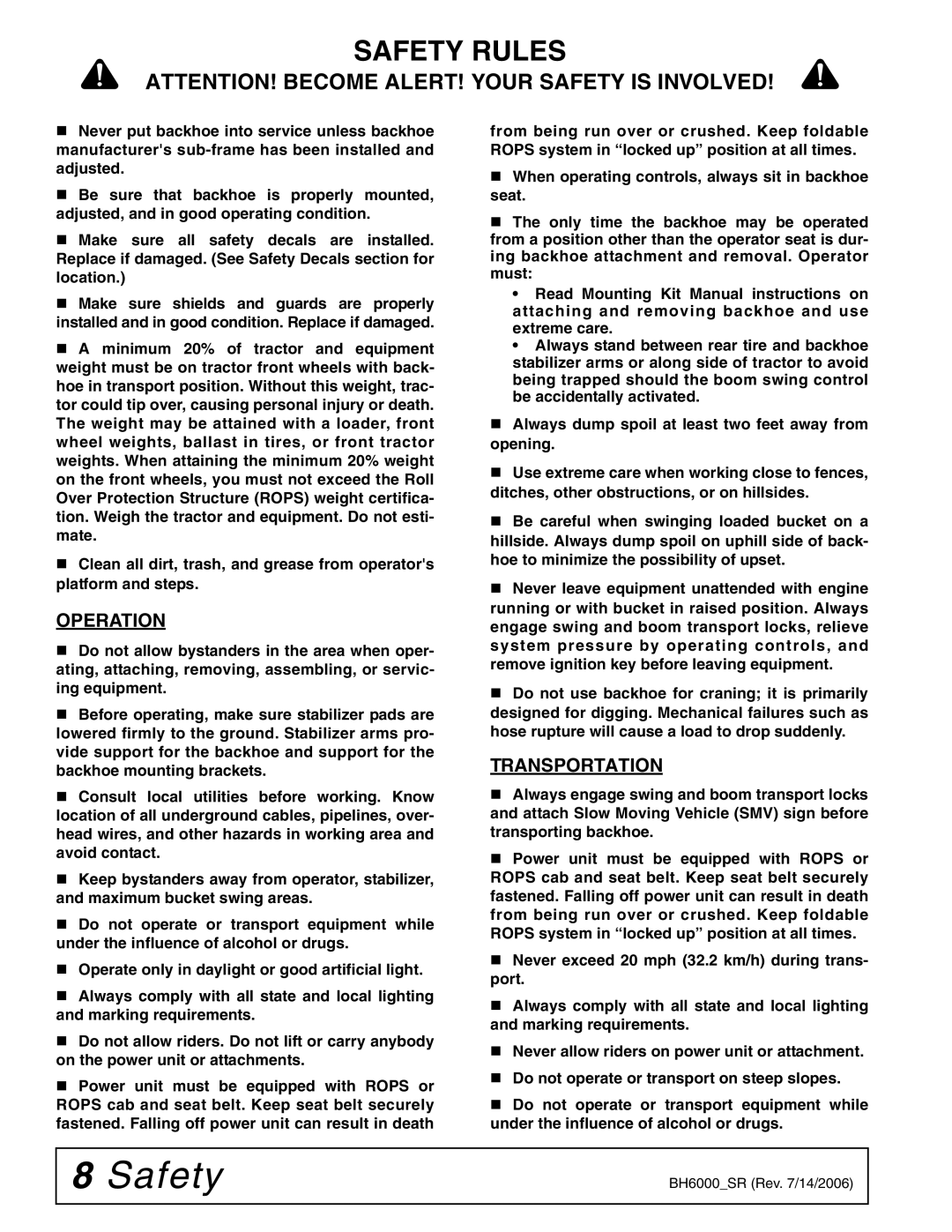
SAFETY RULES
ATTENTION! BECOME ALERT! YOUR SAFETY IS INVOLVED!
Never put backhoe into service unless backhoe manufacturer's
Be sure that backhoe is properly mounted, adjusted, and in good operating condition.
Make sure all safety decals are installed. Replace if damaged. (See Safety Decals section for location.)
Make sure shields and guards are properly installed and in good condition. Replace if damaged.
A minimum 20% of tractor and equipment weight must be on tractor front wheels with back- hoe in transport position. Without this weight, trac- tor could tip over, causing personal injury or death. The weight may be attained with a loader, front wheel weights, ballast in tires, or front tractor weights. When attaining the minimum 20% weight on the front wheels, you must not exceed the Roll Over Protection Structure (ROPS) weight certifica- tion. Weigh the tractor and equipment. Do not esti- mate.
Clean all dirt, trash, and grease from operator's platform and steps.
OPERATION
Do not allow bystanders in the area when oper- ating, attaching, removing, assembling, or servic- ing equipment.
Before operating, make sure stabilizer pads are lowered firmly to the ground. Stabilizer arms pro- vide support for the backhoe and support for the backhoe mounting brackets.
Consult local utilities before working. Know location of all underground cables, pipelines, over- head wires, and other hazards in working area and avoid contact.
Keep bystanders away from operator, stabilizer, and maximum bucket swing areas.
Do not operate or transport equipment while under the influence of alcohol or drugs.
Operate only in daylight or good artificial light.
Always comply with all state and local lighting and marking requirements.
Do not allow riders. Do not lift or carry anybody on the power unit or attachments.
Power unit must be equipped with ROPS or ROPS cab and seat belt. Keep seat belt securely fastened. Falling off power unit can result in death
from being run over or crushed. Keep foldable ROPS system in “locked up” position at all times.
When operating controls, always sit in backhoe seat.
The only time the backhoe may be operated from a position other than the operator seat is dur- ing backhoe attachment and removal. Operator must:
•Read Mounting Kit Manual instructions on attaching and removing backhoe and use extreme care.
•Always stand between rear tire and backhoe stabilizer arms or along side of tractor to avoid being trapped should the boom swing control be accidentally activated.
Always dump spoil at least two feet away from opening.
Use extreme care when working close to fences, ditches, other obstructions, or on hillsides.
Be careful when swinging loaded bucket on a hillside. Always dump spoil on uphill side of back- hoe to minimize the possibility of upset.
Never leave equipment unattended with engine running or with bucket in raised position. Always engage swing and boom transport locks, relieve system pressure by operating controls, and remove ignition key before leaving equipment.
Do not use backhoe for craning; it is primarily designed for digging. Mechanical failures such as hose rupture will cause a load to drop suddenly.
TRANSPORTATION
Always engage swing and boom transport locks and attach Slow Moving Vehicle (SMV) sign before transporting backhoe.
Power unit must be equipped with ROPS or ROPS cab and seat belt. Keep seat belt securely fastened. Falling off power unit can result in death from being run over or crushed. Keep foldable ROPS system in “locked up” position at all times.
Never exceed 20 mph (32.2 km/h) during trans- port.
Always comply with all state and local lighting and marking requirements.
Never allow riders on power unit or attachment.
Do not operate or transport on steep slopes.
Do not operate or transport equipment while under the influence of alcohol or drugs.
8Safety
BH6000_SR (Rev. 7/14/2006)
